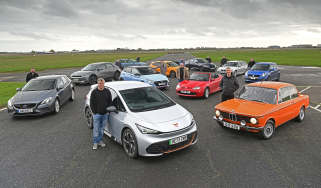Skoda Fabia (2014-2021) review - Engines, performance and drive
Non-turbo, entry-level engines can struggle, but the 1.0 TSI petrol is surprisingly strong

The latest Skoda Fabia is a very accomplished car to drive. It benefits from a chassis that’s well developed, although it's worth noting that the Fabia only gets an evolution of the last car's platform with some additional MQB components, rather than being a complete MQB model like its sister cars, the SEAT Ibiza and Volkswagen Polo.
Precise steering and the lower kerbweight of the latest Fabia mean it handles more neatly than the previous version, proving light on its feet and nimble in town. But sporty handling arguably isn’t as important as comfort in a supermini, and while the Fabia isn't quick, it more than compensates in terms of ride quality.
The damping is forgiving, and the Skoda rides like the Polo. It smothers bad surfaces well, with the dampers controlling body and wheel movement nicely, offering lots of support when driving faster and decent refinement on the motorway. As with the Polo, the steering is direct and the five-speed manual gearbox (or six-speed for the most powerful petrol) serves up positive shifts. For those wanting an automatic supermini, Skoda offers the Fabia 94bhp version with a seven-speed DSG transmission.
At speed, the Fabia is impressively composed, again with the feel of a larger car than it is. This is why you may want to choose the more powerful engine to make it more of an all-rounder: the 1.0 MPI unit struggles when speeds rise. Cabin noise isn't quite as well suppressed from the occupants as it is in a Polo, but it's still an impressive long-distance car for its size. As for brakes, lower-power models have discs at the front but drums at the rear, reflecting the likelihood they’ll be driven more slowly.
Engines, 0-60 acceleration and top speed
The 1.0-litre MPI petrol engine that works so well in the Up and Citigo do struggle a little in the larger Fabia. The five-door supermini isn’t too much of a step up in weight, which helps a bit, but there’s still no escaping the base car’s meek 16.4-second 0-62mph pace.
Used - available now

2023 Skoda
Fabia
16,501 milesManualPetrol1.0L
Cash £14,255
2025 Skoda
Fabia
11,104 milesManualPetrol1.0L
Cash £14,458
2021 Skoda
Fabia
46,354 milesManualPetrol1.0L
Cash £9,395
2021 Skoda
Fabia
12,153 milesAutomaticPetrol1.0L
Cash £13,782Our tip is to choose the 1.0 TSI turbo with 94bhp - or in 108bhp guise if you’re buying a used Fabia. The figures say it all: the 1.0 TSI 95 (that number representing its power in metric horsepower) produces 160Nm of torque, instead of the 1.0 MPI's 95Nm – and does so from lower down the rev range. The TSI 110 version delivers even more shove with torque at 200Nm.
While the MPI and TSI engines are throbby and characterful thanks to their three-cylinder layouts, the 1.0 TSI is much more appealing because you don't need to rev it so hard as to make the engine note intrusive. It fades into the background and often, because it demands so few revs around town, is as refined as a much larger car. A used TSI 110 may prove better on a motorway than the 95 TSI though – it benefits from a six-speed gearbox, and the extra power means you don't have to work it quite as hard.
Skoda's five- and six-speed gearboxes are snappy and ultra-light in the usual Volkswagen Group way, with an accurate and precise shift. This helps the TSI 95 model achieve a 0-62mph time of 10.7 seconds, while the now deleted TSI 110 version shaved a full second off and managed the sprint in 9.7 seconds. When mated to the seven-speed DSG automatic transmission, the TSI 95 reaches 0-62mph in 11.1 seconds.






